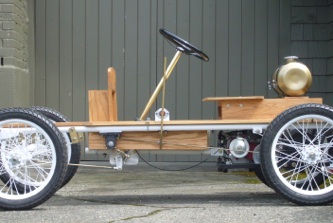De Dion Bouton “Paris - Madrid”

1903 De Dion - Bouton Type S
At the turn of the century, De Dion was the largest car manufacturer in the world. Additionally, De Dion engines were used by many other car makers (some claim by as many as 150).The Type S was built for the infamous 1903 Paris - Madrid Race. This race was halted by the French government at Bordeaux after five drivers, including Marcel Renault, and three spectators had been killed. It was the last town to town race run over public roads. The Type S was also raced in the Coupe d’Ardennes later that year which was one of the earliest closed course races. The Ardennes course evolved over the century to become the track we know now as Spa.
Chassis number: 1101
My De Dion was never intended as a spirited racer but rather as a gentile driver. In fact, the Marquis De Dion claimed that races of speed were useless. The only useful races in his opinion were ones of endurance and fuel efficiency. Great care was taken to make this car comfortable, well mannered and easy to drive.
Engine: Honda GX 200 with Mikuni carburetor mounted on a radiator hose intake manifold. This was necessary to reduce the width of the engine package. In this scheme the carburetor and air cleaner are in line with the the car (instead of angled) and thus the engine fits inside the frame. The exhaust pipe is likewise a special construction welded from mandrel bends to achieve a low exit between the brakes and differential. The exhaust pipe has a heat sock. The De Dion engine is tuned to run slow and steady. It starts on the first pull every time. The Mikuni carburetor is imminently tunable.
Gas tank: Large sand rail type gas tank. No fuel pump.
Drive: GTC Comet type variable drive. #41 chain. 60 tooth driven sprocket. Rear axle utilizes a Peerless differential (same as was used on the Austro-Daimler).
Brakes: Two 8” Ø disk brakes. These are controlled by pull rods to a foot pedal on a cross shaft. A hand lever alternately engages the same system. Two brakes are obligatory on a car with a differential. Brakes work very well and predictably even when this heavy car is loaded with a driver and passenger.
Wheels: 17” generic Chinese dirt bike wheels. The dirt bike wheels were selected for their small hubs. The objective was to get as believable an Edwardian look as possible from the wheels. Hubs were modified with a hole saw to get useful bearings into them (NB: not for the faint of heart).
Tires: 3” Michelin Gazelle. The wheel and tire combination would not look out of place in the tile work on Bibendum in London - just as intended.
Front suspension: Semi elliptic. 2’ x 1 1/4” buggy seat springs. Friction dampers. Panhard rod. King pins run in Heim joints allowing camber adjustment. U-bolts are welded to the front axle and are in turn bolted to plates on the springs allowing fine caster adjustment.
Steering: Steeply angled steering column acts through an angle gear at a 1:1 ratio.
Rear suspension: Semi elliptic (Same spring type as front) with engine sub frame acting as a trailing link (both ends of the rear springs are free). Panhard rod. Provision made for additional coil-over type shock units but these were determined not to be necessary in trials and have been left off.
Bodywork: Mostly oak. A mix of 3/4” solid oak planks and 1/4” oak plywood. Bonnet is aluminum and brass sheet. Seat back is woven fiber and the seat cushion is diamond tufted leather.
Frame: 0.065” wall, 1.5” round steel tube. Off the shelf mandrel bends were utilized where the frame is curved. This steel frame is significantly stiffened by the oak “bodywork”. It is probably more fair to say that the very rigid wood frame has decorative steel trim attached to it.
DIMENSIONS
Wheelbase: 66.5”, ground clearance: 6” (engine subframe)
Front track: 36.75”, rear track: 35.5”
Overall length: 91”
Width at seat: 30”, radiator width 14.5”
Height: 40.5” (steering wheel), height at scuttle: 31.5”, height at seat: 26”
Weight: 305 lbs (cast iron and brass are heavy!)

